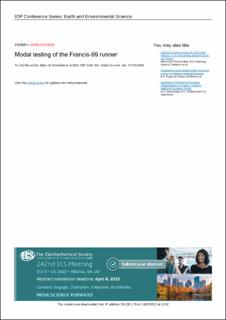| dc.contributor.author | Solemslie, Bjørn Winther | |
| dc.contributor.author | Dahlhaug, Ole Gunnar | |
| dc.contributor.author | Sigurdsson, Bjarki | |
| dc.contributor.author | Tengs, Erik Os | |
| dc.date.accessioned | 2022-08-12T11:37:42Z | |
| dc.date.available | 2022-08-12T11:37:42Z | |
| dc.date.created | 2022-03-11T11:56:00Z | |
| dc.date.issued | 2021 | |
| dc.identifier.citation | IOP Conference Series: Earth and Environmental Science (EES). 2021, 774 (1), . | en_US |
| dc.identifier.issn | 1755-1307 | |
| dc.identifier.uri | https://hdl.handle.net/11250/3011633 | |
| dc.description.abstract | The Francis-99 low specific speed Francis runner has undergone much study in the years since it was first made available to the public. The High Head Francis(HiFrancis) project, hosted by the Waterpower Laboratory at NTNU, have conducted multiple experimental campaigns to supply validation data for numerical simulations of the RSI phenomenon for the runner. Due to the amount of instrumentation on board the runner an asymmetry exists in the runner structure that naturally affects the structural response of the runner. From numerical analysis the runner has been found to exhibit multiple natural modes of vibration, within narrow frequency bands. In order to validate the identified natural frequencies, with their corresponding mode of vibration and the amplitude, an experiment has been conducted. The experiment utilises piezo electric patches mounted on the runner hub to excite the runner in a defined mode of vibration and the response at the trailing edge of all blades is measured with a 1D Laser Doppler Vibrometry scanner. Preliminary results are shown that demonstrate the possibilities with the presented experimental method. Francis runner, Vibration, Modal testing | en_US |
| dc.language.iso | eng | en_US |
| dc.relation.uri | https://iopscience.iop.org/article/10.1088/1755-1315/774/1/012043 | |
| dc.rights | Navngivelse 4.0 Internasjonal | * |
| dc.rights.uri | http://creativecommons.org/licenses/by/4.0/deed.no | * |
| dc.subject | Francis runner | en_US |
| dc.subject | Vibration | en_US |
| dc.subject | Modal testing | en_US |
| dc.title | Modal testing of the Francis-99 runner | en_US |
| dc.type | Peer reviewed | en_US |
| dc.type | Journal article | en_US |
| dc.description.version | publishedVersion | en_US |
| dc.subject.nsi | VDP::Teknologi: 500 | en_US |
| dc.source.pagenumber | 12 | en_US |
| dc.source.volume | 774 | en_US |
| dc.source.journal | IOP Conference Series: Earth and Environmental Science (EES) | en_US |
| dc.source.issue | 1 | en_US |
| dc.identifier.doi | 10.1088/1755-1315/774/1/012043 | |
| dc.identifier.cristin | 2009097 | |
| dc.relation.project | Norges forskningsråd: 254987 | en_US |
| dc.source.articlenumber | 012043 | en_US |
| cristin.ispublished | true | |
| cristin.fulltext | original | |
| cristin.qualitycode | 1 | |

